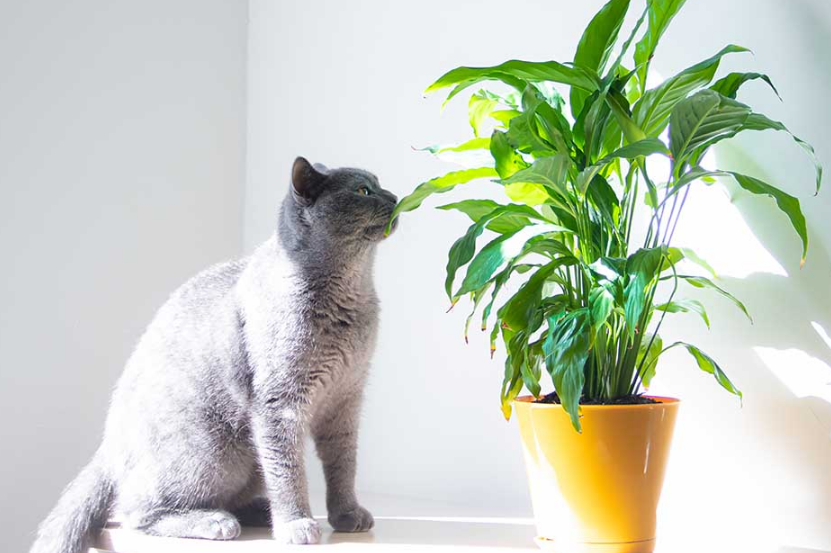Introduction
Houseplants add beauty to our homes, but pet owners must be cautious about plant toxicity. One of the most common questions cat owners ask is, “Is peace lily poisonous to cats?” Unfortunately, the answer is yes. Peace lilies (Spathiphyllum) contain calcium oxalate crystals, which can cause irritation and health issues if ingested by cats. In this article, we’ll explore symptoms of peace lily poisoning, treatment options, and safe alternatives.
Understanding Peace Lily Toxicity
Why Are Peace Lilies Poisonous to Cats?
Peace lilies contain insoluble calcium oxalate crystals, which cause irritation when they come into contact with a cat’s mouth, tongue, and digestive tract. Unlike lilies from the Lilium or Hemerocallis family, peace lilies are not as deadly, but they can still cause significant discomfort and potential health complications.
Symptoms of Peace Lily Poisoning in Cats
If your cat has nibbled on a peace lily, look for these symptoms:
- Excessive drooling
- Pawing at the mouth
- Vomiting
- Difficulty swallowing
- Loss of appetite
- Swollen lips, tongue, or mouth
- Lethargy
How Long Do Symptoms Last?
Symptoms can last anywhere from a few hours to a couple of days, depending on how much of the plant was ingested. If symptoms persist beyond 24 hours, consult a veterinarian.
What to Do If Your Cat Eats a Peace Lily
Immediate Steps to Take
- Remove any plant material from the cat’s mouth. Use a damp cloth to wipe away any residue.
- Offer fresh water or milk. This can help reduce irritation in the mouth.
- Monitor your cat closely. Look for worsening symptoms such as difficulty breathing.
- Call your veterinarian. If symptoms persist, seek medical attention immediately.
When to Seek Emergency Care
If your cat experiences severe reactions like excessive vomiting, trouble breathing, or extreme lethargy, seek emergency veterinary care immediately.
Safe Alternatives to Peace Lilies for Cat Owners
If you love houseplants but want to keep your feline safe, consider these non-toxic alternatives:
- Spider Plant (Chlorophytum comosum)
- Areca Palm (Dypsis lutescens)
- Calathea (Calathea spp.)
- Boston Fern (Nephrolepis exaltata)
- Parlor Palm (Chamaedorea elegans)

How to Keep Cats Away from Toxic Plants
1. Place Plants Out of Reach
Keep plants on high shelves or in hanging baskets.
2. Use Cat Repellents
Citrus sprays, aluminum foil, or motion-activated deterrents can help keep cats away.
3. Provide Cat Grass
Offering safe, edible grass can redirect your cat’s chewing habits.
Frequently Asked Questions
1. Are peace lilies deadly to cats?
Peace lilies are not typically fatal, but they can cause significant discomfort and health issues. Immediate treatment can prevent serious complications.
2. How much of a peace lily is toxic to a cat?
Even a small nibble can cause irritation. Large amounts may lead to more severe symptoms.
3. Can peace lilies cause kidney failure in cats?
Unlike true lilies (Lilium and Hemerocallis species), peace lilies do not cause kidney failure but can still cause severe irritation and discomfort.
4. How do vets treat peace lily poisoning in cats?
Treatment may include IV fluids, anti-inflammatory medications, and monitoring for secondary complications.
5. Can I still keep peace lilies if I have a cat?
It is best to avoid keeping peace lilies if you have a cat, or ensure they are placed where your pet cannot access them.
6. What should I do if my cat eats a peace lily at night?
If symptoms are mild, monitor your cat and provide fresh water. If symptoms worsen, contact an emergency vet immediately.
Conclusion
Peace lilies may be beautiful, but they pose a risk to our feline friends. If you have a cat, it’s best to choose pet-safe plants to prevent accidental ingestion. Understanding the symptoms and acting quickly can help keep your pet safe and healthy. Always consult your veterinarian if you suspect plant poisoning, and consider safer alternatives to keep both your home and your cat happy.

